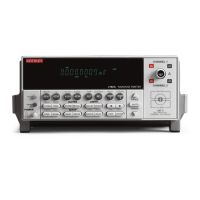9-4 Stepping and Scanning
Front panel trigger models
The front panel trigger models for stepping and scanning are shown in Figure 9-1 and
Figure 9-2. These are expansions of the basic front panel trigger model that is presented and
explained in Section 7 (see Figure 7-1). The following discussions focus on the stepping and
scanning operations. Be sure to refer to Section 7 for additional information on the various
components of trigger models.
Internal scanning
Figure 9-1 shows the front panel trigger model for internal scanning. The components of the
trigger model are explained as follows:
• Control source:
• Immediate — With immediate triggering, event detection occurs immediately
allowing operation to drop down to the next trigger model block (Delay).
• Timer — The timer is used to control the time interval between internal scans. It
has no effect on the time interval between each measurement in a scan cycle. When
SCAN is pressed, the timer starts and event detection occurs immediately allowing
operation to drop down to Delay.
If configured for an additional scan, operation will later loop back to this control
source, where it will wait until the timer interval expires. If the timer interval is
already expired, event detection will be satisfied immediately.
• External trigger — After the internal scan is configured, pressing the EX TRIG
key places the instrument in the external trigger mode. When the SCAN key is
pressed, the internal scan is enabled. However, it doesn’t start until an external trig-
ger is received or the TRIG key is pressed. After the trigger occurs, operation drops
down to the Delay block.
• Delay — If a delay (auto or manual) is being used, operation will hold up at this block
until the delay period expires.
• Device action — Measurements are performed at this block. The first measurement is
performed on Channel 2 of the Model 2182. Subsequent measurements are performed
on Channel 1. Note that every reading is automatically stored in the buffer.
• Sample counter — For each scan cycle, Channel 2 is measured once and Channel 1 is
measured a specified number of times. Therefore, the sample count is the sum of those
two values (CH1 COUNT +1). Operation will continue to loop back to Delay and Device
Action until all the sample readings are taken.
• Output trigger — After the last Channel 1 measurement is performed, an output trigger
is applied to the rear panel Trigger Link connector.
• Trigger counter — The value of this counter determines how many scan cycles will be
performed. If configured for another scan, operation will loop back to the control source
for another pass through the trigger model.

